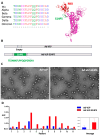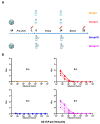Pre-Existing Anti-Vector Immunity to Adenovirus-Inspired VLP Vaccines Shows an Adjuvant-Dependent Antagonism
- PMID: 40266128
- PMCID: PMC11946745
- DOI: 10.3390/vaccines13030238
Pre-Existing Anti-Vector Immunity to Adenovirus-Inspired VLP Vaccines Shows an Adjuvant-Dependent Antagonism
Abstract
Background/Objectives: The use of virus-like particles (VLPs) in vaccinology has expanded significantly in recent years. VLPs have the advantage of being non-infectious while effectively stimulating B cell responses through the repetitive presentation of epitope motifs on their surface. Since VLPs are often derived from human-infecting viruses, preexisting immunity may influence the immune response they elicit, warranting further investigation. Methods: We have developed a 60-mer VLP derived from human adenovirus type 3, a common pathogen. We investigated the impact of pre-existing adenovirus immunity on the immunization outcome against the linear S14P5 epitope of SARS-CoV-2, which was engineered into the particle (Ad-VLP-S14P5). To this end, antibody responses to S14P5 were evaluated following immunization with Ad-VLP-S14P5 in either naive or vector-primed mice. Results: Mice with pre-existing anti-vector immunity exhibited significantly greater anti-S14P5 antibody responses compared to vector-naive animals, demonstrating a beneficial impact of prior anti-adenovirus responses. However, the addition of an oil-in-water adjuvant for the immunizations abolished this positive impact, even leading to a deleterious effect of the pre-existing anti-vector immunity. Conclusions: The data suggest that the immune status against immunizing VLPs must be taken into consideration when designing immunization protocols. Importantly, the effects of prior immunity may vary depending on the nature of the protocol, including factors such as adjuvant use.
Keywords: SARS-CoV-2; VLP; adenovirus; adjuvant; pre-existing immunity.
Conflict of interest statement
The authors declare no conflict of interest.
Figures





Similar articles
-
Immunogenicity of Wild Type and Mutant Hepatitis B Surface Antigen Virus-like Particles (VLPs) in Mice with Pre-Existing Immunity against the Wild Type Vector.Viruses. 2023 Jan 23;15(2):313. doi: 10.3390/v15020313. Viruses. 2023. PMID: 36851527 Free PMC article.
-
Human metapneumovirus virus-like particles induce protective B and T cell responses in a mouse model.J Virol. 2014 Jun;88(11):6368-79. doi: 10.1128/JVI.00332-14. Epub 2014 Mar 26. J Virol. 2014. PMID: 24672031 Free PMC article.
-
Chimeric Hepatitis B core virus-like particles harboring SARS-CoV2 epitope elicit a humoral immune response in mice.Microb Cell Fact. 2023 Feb 25;22(1):39. doi: 10.1186/s12934-023-02043-z. Microb Cell Fact. 2023. PMID: 36841778 Free PMC article.
-
Virus-like particles: preparation, immunogenicity and their roles as nanovaccines and drug nanocarriers.J Nanobiotechnology. 2021 Feb 25;19(1):59. doi: 10.1186/s12951-021-00806-7. J Nanobiotechnology. 2021. PMID: 33632278 Free PMC article. Review.
-
Current status and future directions of fish vaccines employing virus-like particles.Fish Shellfish Immunol. 2020 May;100:49-57. doi: 10.1016/j.fsi.2020.02.060. Epub 2020 Mar 1. Fish Shellfish Immunol. 2020. PMID: 32130976 Review.
References
Grants and funding
LinkOut - more resources
Full Text Sources
Miscellaneous

